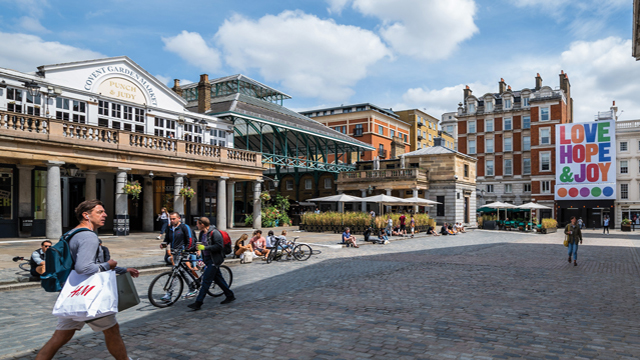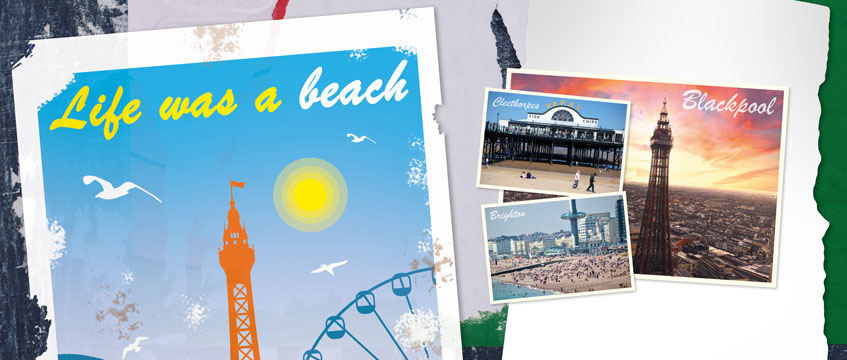Oh, we do like to be beside the seaside. And with Covid’s enforced staycations bringing even greater numbers to Britain’s coastal towns and cities, a new golden age could be dawning. With the help of a few billion pounds of regeneration, that is.
From their heyday in the Victorian era to the depths of decline in the 1990s and 2000s, to the recent wave of regenerations, the fortunes of Britain’s seaside towns and cities have ebbed and flowed like the tide.
Now, it seems, the tide is high.
Visitor numbers, which have been climbing steadily since 2015, went stratospheric during Covid restrictions. With no other options for travel and an enormous desire to flee the cities, Britain headed for the coast.
“People are rediscovering what makes these places great,” says Wayne Hemingway, whose practice, Hemingway Design, is currently active on about a dozen coastal regeneration projects.
“There is no agonising over what made the places attractive. Big skies, beaches, promenades. And that sense of getting away from it all. That’s what people wanted and that’s what people will always want. It’s not rocket science.”
Riding a wave
But Britain’s coast needs help. It needs regeneration. Hemingway has just won approval for its Cleethorpes masterplan. It also has regeneration projects under way at Bangor, Scarborough Harbour, Southend, Lowestoft, Margate… the list goes on. “I don’t think we are bucking any kind of trend at the moment,” he says modestly. “People say, ‘Oh, you’re doing so many of these, how do you do it?’ Well, it’s not hard. We’re riding a wave.”
Earlier this year, Hemingway’s practice was given the green light for a masterplan for Bangor in Northern Ireland. Bangor is Britain’s latest coastal city, having been granted the status as part of the Queen’s Platinum Jubilee celebrations.
Hemingway wants it to become the Brighton of Belfast. “Paramount was bringing out the essence of Bangor and reinforcing its connection to the sea and landscape.”
Now, along with Ards & North Down Borough Council and AECOM, it has received more than £62m in City Deal funding to put the plan into practice.
Across the Irish Sea from Bangor is Blackpool, Britain’s biggest coastal town.
Note that, by the way. Still a town. Despite several attempts over the years – including this year, when it reached the shortlist – Blackpool has yet to make it to city status.
Last week a gaping hole appeared in the ground, just to the south of the famous tower and a stone’s throw from the beach. The hole means construction work has finally started on Nikal and Media Invest Entertainment’s £300m Blackpool Central redevelopment, the latest and greatest in a long line of planned regenerations.
The Gensler-designed scheme hopes to “revitalise and support Blackpool’s growth and regeneration”. It is also the biggest investment in the town since Blackpool Tower opened in 1894.
Admittedly, the first element is not the most exciting part of the scheme. Eventually the site, once home to Blackpool’s Central railway station, will host an indoor theme park and heritage quarter. But first comes the car park. “It isn’t sexy, but it is important,” says one person working on the project. Its 1,306 spaces are crucial to freeing up the rest of the site, and also the wider regeneration.
“This is an important step forward and builds momentum behind Blackpool Central,” says Richard Fee, chief executive of Nikal.
Because, despite it’s rediscovered popularity – 18m people are now heading to Blackpool each year – and despite the flagship projects – including the 1.1m sq ft regeneration of Talbot Gateway – Blackpool is still in desperate need of levelling up.
The Levelling Up white paper named Blackpool one of 20 areas ripe for another King’s Cross, which it promised would “turbocharge” the seaside town. But it has not received any funding from the Levelling Up Fund, having to make do with £40m from the Town Deal.
Indeed, with the Coastal Community Fund being scrapped last year, there is now no specific funding targeting coastal regeneration. In addition to that, none of the major agents have a dedicated coastal team. No wonder the coast feels somewhat neglected at times.
The most recent statistics on deprivation date back to 2019. But they show that eight of the 10 most deprived areas in England were in Blackpool. In fact, 41% of its neighbourhoods were classed as highly deprived.
But, while extreme, Blackpool is not unusual in this. The most deprived area of all was Jaywick in Essex, another seaside town.
Missing elements
In fact, a glance at a map of England’s most deprived areas shows an interesting theme. A dark red band – the darker the colour the more deprived – stretches across the industrial north, the prime target of the government’s levelling-up agenda. But the rest of the deep red is on the fringes. On the coast.
A House of Lords committee in April 2019 said seaside towns needed all the help they could get. The committee’s chair, Lord Bassam of Brighton, said: “For too long, seaside towns have been neglected. They suffer from issues rooted in the decline of their core industries, most notably domestic tourism, but also in fishing, shipbuilding and port activity, and from their location at the ‘end of the line’.”
Ministers say work is already in progress and government is investing in bringing our seaside towns and cities back to life.
In his response to the House of Lords’ 2019 committee (in June 2021), Luke Hall, minister for regional growth and local government, said the UK’s coastal economies and communities added “unique value” to the country and the government had shown how committed it was to unlocking growth through the announcement of eight freeports around the country, seven of which are in coastal areas.
It is hoped those freeports will bring international trade, new business and fresh investment with them.
What they don’t bring is a fresh approach to planning, which is what Hemmingway reckons has been the biggest culprit when it comes to the decline of our seaside towns. “It’s disastrous planning policies and poor central decision making combined with people not getting how society is moving forward and what changes are needed,” says Hemingway.
Creating something special
The big holes in the ground serve a purpose, but it’s no good if you end up building the wrong things. That, he says, is where previous coastal regeneration has gone wrong.
“Often regeneration focuses around engineering and what can roads do and what can you build. But really it’s about people and what they want.”
Hemingway would far rather he didn’t have to do anything. “I get criticised for that in the industry that we’re in. It makes me a bit of a heretic,” he says, laughing. “But give me a couple of million that was earmarked for new paving on the seafront, and let me spend that working with people to take an old shop and turn it into something special.
“That’s regeneration. It’s much better than putting a lot of new benches on the seafront,” he says. “No one is going to say: ‘I think I’m going to go to this coastal resort because they’ve put in some really nice benches.’ Obviously all that’s important, but there’s no point doing it if you have got a dull place and nothing is happening.”
The reason people are returning to the seaside is because things are happening.
“The narrative has changed among people who are leading,” says Hemingway. He doesn’t mean leading in a political sense, or even development. He means it from a marketing perspective. The “leaders”, the early adopters, the cool kids. They are now thinking ‘why are we ignoring all this great stuff we have got on our doorstep?’
A weekend in Benidorm or Malaga has been taken off the table. Sustainability is a big reason behind that, as is cost, Brexit, and Covid.
Thosee leaders are heading to the coast. And more will follow them. “There is only one direction of travel,” says Hemingway. “The days of cheap flights aren’t coming back.”
So are we heading into another golden age for Britain’s coasts? “I think we are already in it,” says Hemingway.
“Obviously there is a lot of catching up to do for some places. But if coastal towns can’t make great progress now, then when is it going to happen?”
To send feedback, e-mail piers.wehner@eg.co.uk or tweet @PiersWehner or @EGPropertyNews











